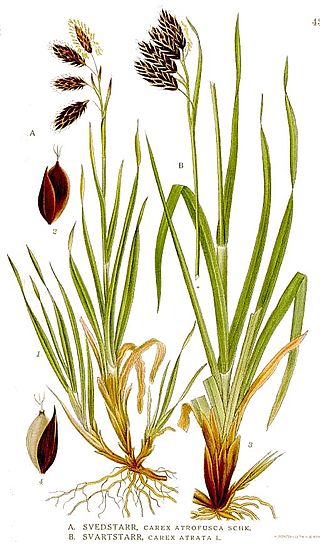
Uncinia is a genus of flowering plants in the family Cyperaceae, known as hook-sedges in Australia and as hook grasses or bastard grasses in New Zealand. The genus is characterised by the presence of a long hook formed by an extension of the rachilla, which is used to attach the fruit to passing animals (epizoochory), especially birds, and it is this feature which gives the genus its name, from the Latin uncinus, meaning a hook or barb.

Carex arctata, known as drooping woodland sedge, is a species of sedge native to eastern North America. It is sometimes called black sedge, compressed sedge, or drooping wood sedge. It occurs from Manitoba to the Maritimes in Canada, south to northwestern North Carolina, and west to Minnesota. Carex arctata grows in bogs, hardwood forests, and spruce forests.
Carex barbata is a Tasmanian species of sedge that was first formally named by Francis Boott in 1858, in his Illustrations of the genus Carex. A specimen collected in February 1839 by R. C. Gunn is the only known collection of this species. In 1909, it was reclassified as a variety of Carex gunniana, but Kew's Plants of the World Online maintains it as a separate species.
Carex bichenoviana, the plains sedge, is a species of sedge that was first formally named by Francis Boott in 1858. It is native to eastern Australia and has been introduced to New Zealand. It has previously been considered a variety of Carex pumila.
Carex gunniana is an Australia species of sedge that was first described in 1845 by Boott in the Proceedings of the Linnean Society of London. It is native to eastern Australia and Tasmania.

Carex lanceolata is a species of sedge, native to the eastern half of China, Mongolia, eastern Siberia, Korea, Sakhalin, and Japan. Its seeds are dispersed by ants.

Carex morrowii, the kan suge, Morrow's sedge, Japanese grass sedge or Japanese sedge, is a species of flowering plant in the family Cyperaceae. It is native to central and southern Japan, and has been introduced to Belgium, Denmark and Austria.

Carex fascicularis, commonly known as tassel sedge, is a species of sedge of the family Cyperaceae that is native to Australia, New Zealand and New Guinea.

Carex caryophyllea is a species of plant in the family Cyperaceae first described by Marc Antoine Louis Claret de La Tourrette. Two varieties are listed in the World Checklist of Selected Plant Families:
Carex aematorhyncha is a species of flowering plant in the sedge family, Cyperaceae, native to South America. It was first formally named in 1854 in the sixth volume of Flora chilena.

Carex stipata, variously called the prickly sedge, awl-fruited sedge, awlfruit sedge, owlfruit sedge, swamp sedge, sawbeak sedge, stalk-grain sedge and common fox sedge, is a species of flowering plant in the genus Carex, native to Canada, the United States, China, Korea, Japan, and Far Eastern Russia. It is a wetland obligate.

Carex atrata, called black alpine sedge, is a widespread species of flowering plant in the genus Carex, native to Greenland, Iceland, and most of Europe, plus scattered locations across temperate Asia, including Anatolia, Siberia and the Himalaya, as far as Taiwan and Japan. Its chromosome number is 2n=52, with some variants reported, e.g. n2=54 for Greenland material.

Carex breviculmis, called the Asian shortstem sedge, is a species of flowering plant in the genus Carex, native to Asia from the Indian subcontinent to Southeast Asia, China, Taiwan, Korea, Japan, north as far as Khabarovsk Krai, and Malesia, New Guinea, Australia, Norfolk Island and New Zealand. It has been introduced to the US state of Mississippi. Typically found in forests, it is quite shade tolerant.

Carex muehlenbergii is a species of flowering plant, it is a type of sedge. It is a grass-like plant in the family Cyperaceae. Its common names include sand sedge, Muhlenberg's sedge.

Carex tristachya, called the shiny-spike sedge, is a species of flowering plant in the genus Carex, native to south-central and southeast China, Korea, Japan, the Ryukyus, the Philippines, Borneo, and New Guinea. Its seeds are dispersed by ants.

Carex punctata, the dotted sedge, is a species of flowering plant in the genus Carex, native to Macaronesia, northwest Africa, southern, central, and northern Europe, and Turkey. Its chromosome number is 2n=68.

Carex gaudichaudiana, also known as fen sedge, is a tussock-forming species of perennial sedge in the family Cyperaceae. It is native to parts of Australia and New Zealand.
Carex interrupta is a tussock-forming species of perennial sedge in the family Cyperaceae. It is native to south eastern parts of Canada and north eastern parts of the United States.













